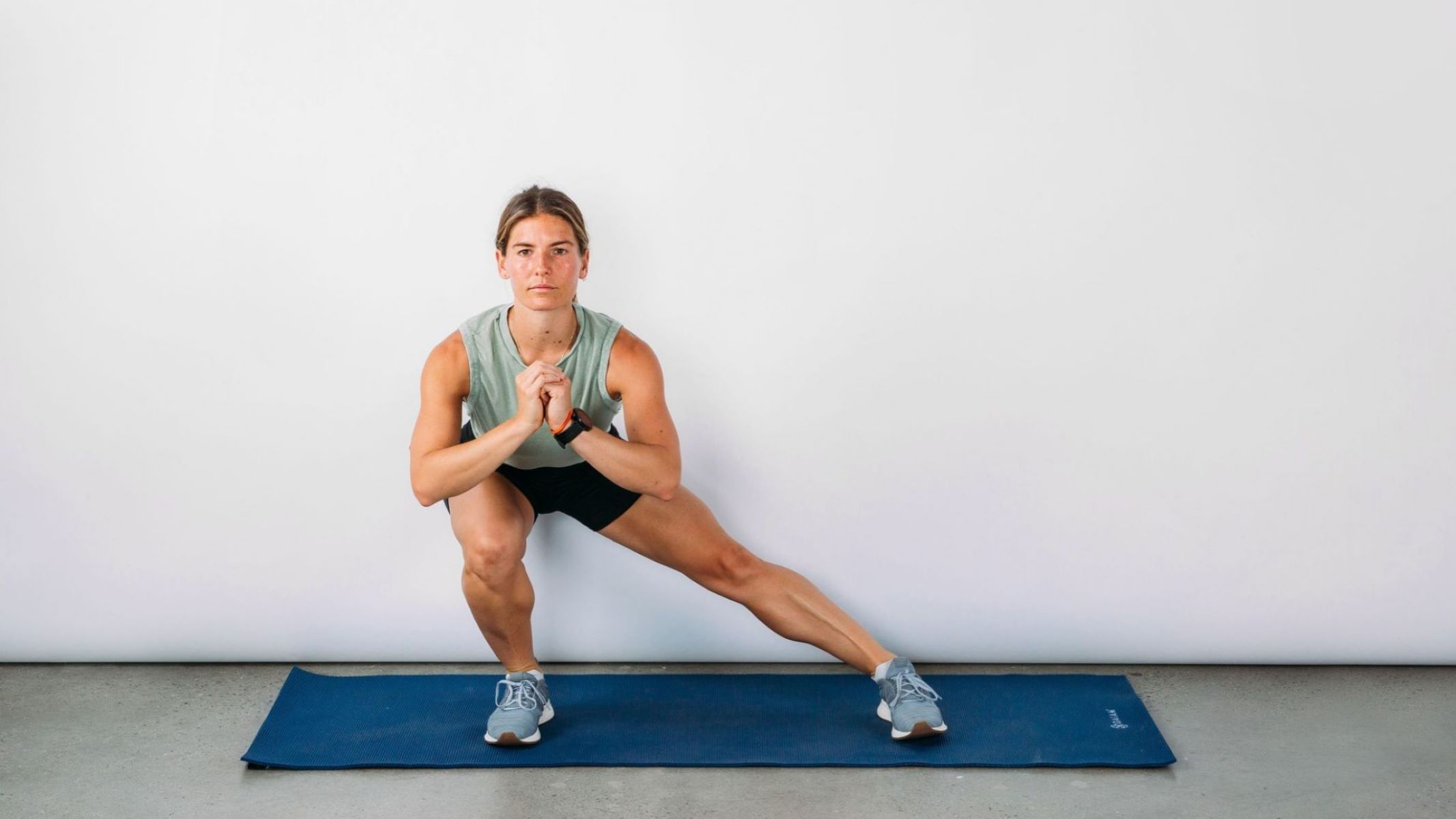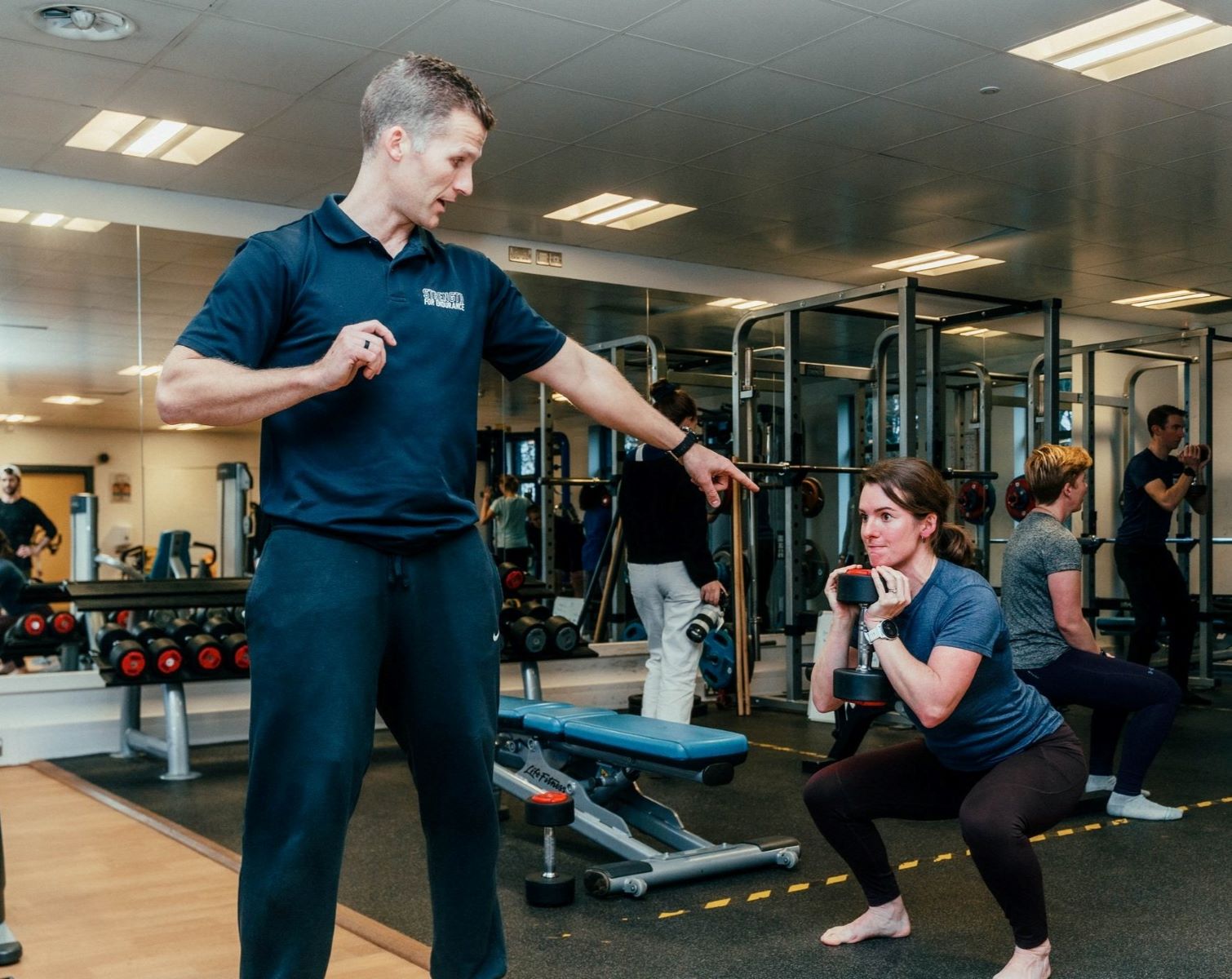Home>Misc>Featured>Which Activity Will Most Likely Promote Cardiorespiratory Endurance?


Featured
Which Activity Will Most Likely Promote Cardiorespiratory Endurance?
Modified: March 2, 2024
Discover the featured activity that is most likely to promote cardiorespiratory endurance and give your fitness journey a boost.
Introduction
Cardiorespiratory endurance, also known as cardiovascular endurance, is a critical component of physical fitness. It refers to the ability of the heart, lungs, and blood vessels to supply oxygen to the working muscles during prolonged physical activity. In simpler terms, it is the measure of how well your body can efficiently utilize oxygen during exercise.
Having good cardiorespiratory endurance is vital for overall health and well-being. It not only helps to improve your physical performance but also plays a significant role in reducing the risk of chronic diseases such as heart disease, diabetes, and obesity.
Improving your cardiorespiratory endurance requires consistent effort and the right activities. Engaging in exercises that specifically target the cardiovascular system can help to strengthen your heart and lungs, increase your stamina, and enhance your overall fitness.
In this article, we will explore various activities that can promote cardiorespiratory endurance. Whether you are a novice looking to improve your fitness level or an athlete seeking to enhance your performance, incorporating these activities into your routine can help you achieve your goals.
What is Cardiorespiratory Endurance?
Cardiorespiratory endurance, also known as cardiovascular endurance, is a measure of your body’s ability to sustain prolonged aerobic exercise. It is a combination of the function and efficiency of your heart, lungs, blood vessels, and muscles working together to supply oxygen to the body during physical activity.
When you engage in exercises that require an increased demand for oxygen, such as running, cycling, or swimming, your cardiovascular system works harder to deliver oxygen to your muscles. Your heart pumps blood more efficiently, your lungs expand to take in more oxygen, and your blood vessels dilate to ensure a steady flow of oxygen-rich blood to the muscles.
The ability to maintain aerobic exercise for an extended period is an indication of good cardiorespiratory endurance. It is measured by variables such as VO2 max, which represents the maximum amount of oxygen your body can use during exercise. The higher your VO2 max, the greater your cardiorespiratory endurance.
Having good cardiorespiratory endurance offers numerous benefits. It allows you to perform physical activities with less fatigue, exercise for longer durations without feeling out of breath, and recover faster between bouts of exercise. Additionally, it reduces the risk of cardiovascular diseases, improves mental health, and enhances overall quality of life.
Improving cardiorespiratory endurance is essential for individuals of all fitness levels. Whether you are a beginner or an advanced athlete, working on your cardiovascular fitness can help you achieve better athletic performance, burn more calories, and maintain a healthier lifestyle.
The Importance of Cardiorespiratory Endurance
Cardiorespiratory endurance is a vital component of physical fitness and plays a significant role in maintaining overall health and well-being. Here are several reasons why cardiorespiratory endurance is important:
1. Improved Cardiovascular Health: Engaging in activities that promote cardiorespiratory endurance strengthens your heart muscle, improves blood circulation, and lowers the risk of developing heart disease, high blood pressure, and other cardiovascular conditions.
2. Enhanced Stamina and Endurance: Good cardiorespiratory endurance increases your stamina, allowing you to engage in physical activities for longer periods without feeling fatigued. It improves your overall endurance, making daily tasks and physical exertion easier to manage.
3. Effective Weight Management: Regular aerobic exercise, which helps improve cardiorespiratory endurance, is an effective way to burn calories and maintain a healthy weight. It boosts your metabolism and aids in fat loss, contributing to weight management and preventing obesity-related health issues.
4. Increased Energy Levels: Improved cardiorespiratory endurance helps deliver oxygen and nutrients more efficiently to your muscles and organs, leading to increased energy levels throughout the day. You’ll feel more energized, alert, and ready to take on daily tasks and challenges.
5. Stress Reduction: Engaging in aerobic exercises, which promote cardiorespiratory endurance, triggers the release of endorphins, also known as “feel-good” hormones. These hormones help reduce stress levels, improve mood, and alleviate symptoms of anxiety and depression.
6. Better Cognitive Function: Regular cardiovascular exercise improves blood flow to the brain, enhancing cognitive function, memory, and focus. It promotes brain health, reducing the risk of age-related cognitive decline and neurodegenerative diseases.
7. Longevity: Maintaining good cardiorespiratory endurance is associated with a longer and healthier life. It reduces the risk of chronic diseases and improves overall longevity by promoting optimal health and physical function.
Incorporating activities that enhance cardiorespiratory endurance into your exercise routine is essential for achieving these benefits and maintaining overall fitness and well-being.
Factors Affecting Cardiorespiratory Endurance
Several factors can impact an individual’s cardiorespiratory endurance and their ability to perform aerobic exercises effectively. Understanding these factors can help you identify areas of improvement and tailor your training to enhance your cardiovascular fitness. Here are some key factors:
1. Genetics: Genetic factors play a role in determining a person’s baseline level of cardiorespiratory endurance. Some individuals may naturally have a higher aerobic capacity, while others may have a lower capacity. However, it is important to note that genetic potential can be improved through training and lifestyle modifications.
2. Age: Age can affect cardiorespiratory endurance. As we get older, our aerobic capacity tends to decline. However, regular aerobic exercise can help mitigate this decline and maintain cardiovascular fitness as we age.
3. Body Composition: Body composition, specifically the ratio of lean muscle mass to body fat, can influence cardiorespiratory endurance. Individuals with a higher percentage of lean muscle mass often have a higher aerobic capacity due to their increased ability to utilize oxygen during exercise.
4. Training Status: Whether you are a beginner or an experienced athlete, your level of training can impact cardiorespiratory endurance. Regular aerobic training, such as jogging, cycling, or swimming, can improve your cardiovascular fitness and enhance your endurance over time.
5. Training Intensity: The intensity of your aerobic workouts is a crucial factor that affects cardiorespiratory endurance. Higher-intensity exercises challenge the cardiovascular system more and can elicit greater improvements in aerobic capacity compared to lower-intensity activities.
6. Training Frequency and Duration: The frequency and duration of your aerobic workouts also play a role in your cardiorespiratory endurance. Consistent training sessions that last at least 150 minutes per week, spread across several days, can enhance cardiovascular fitness more effectively than sporadic or shorter workouts.
7. Nutrition and Hydration: Proper nutrition and hydration are essential for supporting cardiorespiratory endurance. Consuming a balanced diet rich in carbohydrates, proteins, and healthy fats provides the necessary energy for aerobic exercise. Staying hydrated helps optimize blood flow and oxygen delivery to your working muscles.
8. Health Conditions and Medications: Underlying health conditions, such as cardiovascular diseases or respiratory disorders, can affect cardiorespiratory endurance. Certain medications may also impact heart rate, blood pressure, or lung function, potentially influencing aerobic capacity and exercise performance.
By considering these factors and making necessary adjustments, you can optimize your cardiorespiratory endurance training and work towards improving your cardiovascular fitness.
Activities to Promote Cardiorespiratory Endurance
Engaging in specific activities that target the cardiovascular system is key to improving cardiorespiratory endurance. Here are some effective exercises that can help promote cardiovascular fitness:
1. Running: Running is a highly effective aerobic exercise that can be done outdoors or on a treadmill. It helps strengthen the heart, lungs, and leg muscles while improving overall stamina. Start with a brisk walk and gradually increase speed and distance to challenge your cardiovascular system.
2. Cycling: Cycling is a low-impact activity that provides an excellent cardiovascular workout. Whether on a stationary bike or cycling outdoors, it strengthens the lower body muscles, improves endurance, and enhances cardiorespiratory fitness. Increase resistance or try uphill cycling to intensify your workout.
3. Swimming: Swimming is a full-body, non-weight-bearing exercise that provides an excellent cardiovascular workout. It engages multiple muscle groups, improves lung capacity, and enhances cardiovascular endurance. Try various swimming strokes or incorporate interval training for added intensity.
4. Jumping Rope: Jumping rope is a simple yet effective exercise that can be done anywhere. It improves coordination, strengthens the lower body, and elevates heart rate, making it an excellent cardio workout. Start with shorter sets and gradually increase duration and intensity.
5. High-Intensity Interval Training (HIIT): HIIT involves alternating between bursts of high-intensity exercise and short recovery periods. This type of training is highly effective for improving cardiorespiratory endurance as it challenges the cardiovascular system and boosts metabolism. Incorporate exercises like squat jumps, burpees, and mountain climbers into your HIIT routine.
6. Group Fitness Classes: Participating in group fitness classes such as aerobic dance, kickboxing, or Zumba can provide a fun and energizing way to improve cardiorespiratory endurance. These classes often involve continuous movement, incorporating both cardiovascular and muscular endurance exercises.
7. Circuit Training: Circuit training involves performing a series of exercises targeting different muscle groups with minimal rest in between. It combines cardiovascular and strength training, helping to improve overall fitness and endurance. Include exercises like jumping jacks, push-ups, squats, or lunges in your circuit.
8. Sports Activities: Engaging in team sports like basketball, soccer, or tennis can be an enjoyable way to improve cardiovascular fitness. These activities involve periods of high-intensity movements, challenging the cardiovascular system and enhancing endurance.
Remember to start slowly and gradually increase the duration and intensity of your workouts. It is important to listen to your body and consult with a healthcare professional before starting any new exercise program, especially if you have any underlying medical conditions.
Running
Running is a popular and effective activity that promotes cardiorespiratory endurance. It is a versatile exercise that can be performed both indoors on a treadmill or outdoors. Running offers numerous benefits for cardiovascular fitness and overall health. Here’s why running is an excellent choice to improve cardiorespiratory endurance:
1. Cardiovascular Fitness: Running is a high-intensity aerobic exercise that significantly elevates heart rate and engages the cardiovascular system. It strengthens the heart muscle, improves blood circulation, and enhances the overall efficiency of the cardiovascular system.
2. Improved Endurance: Regular running helps increase your stamina and endurance. By challenging yourself with increasing distances or durations, you can gradually build up your cardiorespiratory endurance over time. This allows you to sustain physical activity for longer periods without experiencing excessive fatigue.
3. Weight Management: Running is an effective calorie-burning exercise, making it beneficial for weight management. It can help create a calorie deficit, leading to fat loss and weight maintenance. The higher the intensity and longer the duration of your runs, the more calories you will burn.
4. Mental Health Benefits: Running has been shown to have positive effects on mental health. It releases endorphins that promote feelings of happiness and relaxation, helping reduce stress, anxiety, and symptoms of depression. It can also improve cognitive function and boost overall mood.
5. Convenience and Accessibility: Running is a convenient and accessible activity. You can run almost anywhere, whether it’s on a track, trail, or sidewalk. There’s no need for specialized equipment or a gym membership, making it a cost-effective form of exercise.
6. Versatility: Running can be adapted to suit different fitness levels and goals. Beginners can start with a walk-run approach, gradually increasing the running intervals over time. Intermediate and advanced runners can vary their pace, incorporate intervals, or tackle challenging terrains to further improve their endurance.
7. Social Opportunities: Running can be a solitary activity, providing a sense of solitude and self-reflection. However, it can also be a social activity, allowing you to connect with other runners through group runs, charity events, or local running clubs. This social interaction can enhance motivation and create a supportive network.
Before starting a running routine, it’s important to have proper running shoes, warm up adequately, and gradually increase your mileage to prevent injuries. Listen to your body and rest when needed to avoid overtraining.
Whether you’re a beginner or an experienced runner, incorporating running into your fitness regimen can significantly improve your cardiorespiratory endurance and contribute to a healthier lifestyle.
Cycling
Cycling is a fantastic activity for promoting cardiorespiratory endurance while being low-impact on the joints. Whether you prefer stationary cycling or hitting the open road, cycling offers a host of benefits for improving cardiovascular fitness. Here’s why cycling is an excellent choice to enhance your cardiorespiratory endurance:
1. Cardiovascular Health: Cycling is a great aerobic exercise that elevates your heart rate, increasing blood flow and oxygen delivery to your muscles. Regular cycling strengthens your heart, improves circulation, and enhances the efficiency of your cardiovascular system.
2. Stamina and Endurance: Cycling helps improve stamina and endurance by challenging your cardiovascular system. As you gradually increase intensity, duration, and resistance, your body adapts to the demands, allowing you to sustain physical activity for longer periods without fatigue.
3. Low-Impact Exercise: Cycling is gentle on the joints, making it an ideal option for individuals with joint pain or those looking for a low-impact alternative to high-impact activities like running. It reduces stress on the knees, ankles, and hips while providing an effective cardiovascular workout.
4. Weight Management: Cycling is a calorie-burning exercise that can contribute to weight management. It helps burn calories, reduces body fat, and improves metabolic rate. The intensity of your cycling workouts and the duration of your rides can influence the number of calories burned.
5. Mental Well-Being: Cycling, like any physical activity, helps release endorphins, promoting feelings of happiness and reducing stress and anxiety. Cycling outdoors provides an opportunity to connect with nature, which can have additional mood-boosting effects.
6. Commuting and Transportation: Cycling has the added benefit of being a mode of transportation. Choosing to cycle instead of driving or taking public transport can help incorporate physical activity into your daily routine, making it an efficient way to improve cardiorespiratory endurance.
7. Variety and Adaptability: Cycling offers versatile options to cater to different fitness levels and preferences. Whether it’s road cycling, mountain biking, indoor cycling classes, or stationary biking, you can find a cycling activity that suits your interests and fitness goals.
8. Social Opportunities: Cycling can be a social activity, allowing you to join group rides, cycling clubs, or participate in cycling events. Cycling with others provides motivation, accountability, and the chance to connect with like-minded individuals who share your passion for cycling.
Before beginning a cycling routine, ensure that you have a well-fitted bike and proper safety gear. Start with shorter rides and gradually increase distance and intensity to avoid overexertion or injury. Remember to hydrate properly and incorporate rest days into your training schedule.
Whether you choose outdoor cycling or indoor stationary cycling, incorporating cycling into your fitness routine is a great way to improve your cardiorespiratory endurance, strengthen your heart, and enjoy the many benefits of this enjoyable and accessible exercise.
Swimming
Swimming is a highly effective activity for promoting cardiorespiratory endurance while being gentle on the joints. It engages the entire body, making it an excellent choice for improving cardiovascular fitness. Here’s why swimming is a great option to enhance your cardiorespiratory endurance:
1. Full-Body Workout: Swimming is a low-impact, full-body exercise that engages multiple muscle groups simultaneously. It strengthens the major muscle groups, including the arms, legs, back, and core, while also challenging the cardiovascular system for improved endurance.
2. Cardiovascular Fitness: Swimming elevates your heart rate and improves respiratory function. It stimulates the cardiovascular system, improving the efficiency of the heart and lungs and increasing oxygen delivery to the muscles. Regular swimming sessions can significantly enhance your cardiorespiratory endurance.
3. Low-Impact Exercise: Swimming is gentle on the joints due to the buoyancy of the water, making it an ideal choice for individuals with joint pain or those recovering from injuries. It reduces the impact on the joints, allowing for a greater range of motion without placing excessive stress on the body.
4. Improved Lung Capacity: Swimming requires controlled breathing techniques, which can help to improve lung capacity and oxygen utilization. The rhythmic breathing patterns in swimming can enhance respiratory function, making your cardiovascular system more efficient.
5. Weight Management: Swimming is a calorie-burning exercise that can aid in weight management. It activates multiple muscle groups, which helps increase the metabolic rate and burn calories. The resistance of the water also adds an additional challenge, resulting in a higher calorie expenditure.
6. Increased Flexibility and Range of Motion: Swimming involves a wide range of motions, which helps improve flexibility and joint mobility. The water provides resistance, allowing you to move freely and perform dynamic stretches that can enhance your overall flexibility and range of motion.
7. Stress Relief: Swimming has a calming effect on the mind and can promote relaxation and stress relief. The water provides a unique environment that allows you to focus and disconnect from outside distractions, creating a sense of tranquility and promoting mental well-being.
8. Versatility and Safety: Swimming offers a variety of ways to challenge yourself and enhance your cardiorespiratory endurance. You can vary your strokes, incorporate interval training, or try water aerobics for additional cardiovascular benefits. Additionally, swimming is a safe activity for all ages and fitness levels.
Whether you’re a beginner or an experienced swimmer, incorporating swimming into your fitness routine can have a profound impact on your cardiorespiratory endurance. Start with shorter swim sessions and gradually increase the duration and intensity to build your stamina and enjoy the many benefits of this enjoyable and effective exercise.
Jumping Rope
Jumping rope is a simple yet highly effective exercise for promoting cardiorespiratory endurance. It is a versatile activity that can be done almost anywhere, making it a convenient option to incorporate into your fitness routine. Here’s why jumping rope is an excellent choice to improve cardiorespiratory endurance:
1. Cardiovascular Workout: Jumping rope is a high-intensity aerobic exercise that elevates your heart rate, making it an excellent cardio workout. It challenges your cardiovascular system, improving endurance and strengthening your heart and lungs.
2. Full-Body Exercise: Jumping rope engages multiple muscle groups, including the calves, quads, glutes, shoulders, and core. This full-body engagement not only improves cardiovascular fitness but also enhances muscular endurance and coordination.
3. Portability and Convenience: Jumping rope requires minimal equipment and space, making it a convenient exercise option. You can easily pack a jump rope in your bag and fit in a quick workout no matter where you are, whether it’s at home, in the park, or during travel.
4. Calorie Burning: Jumping rope is a high-calorie burning exercise that can aid in weight management. It is estimated that jumping rope can burn about 10-15 calories per minute, depending on your intensity level. This makes it an efficient exercise for those looking to burn calories and lose body fat.
5. Improved Coordination and Balance: Jumping rope requires coordination and balance to maintain a steady rhythm. Regularly incorporating jumping rope into your routine can help improve these skills, enhancing overall athletic performance and agility.
6. Bone Health: Jumping rope is a weight-bearing exercise that can help improve bone density and reduce the risk of osteoporosis. The impact of jumping stimulates bone strength, making it beneficial for maintaining healthy bones and preventing age-related bone loss.
7. Variety of Intensity Levels: Jumping rope allows you to adjust the intensity to match your fitness level. Beginners can start with basic jumps and gradually progress to more advanced techniques such as double unders or alternating foot jumps. This versatility makes it suitable for individuals of all fitness levels.
8. Improvement in Cardiovascular Health: Regular jumping rope can lead to significant improvements in cardiovascular health indicators such as lower blood pressure and reduced resting heart rate. It can also enhance lung capacity and oxygen utilization, increasing overall cardiovascular efficiency.
When starting a jumping rope routine, ensure you have a proper-sized rope and a suitable surface to exercise on. Begin with a light warm-up and gradually increase the intensity and duration of your jumps. Remember to land softly on the balls of your feet and maintain good posture throughout the exercise.
Jumping rope is a fun and challenging way to improve your cardiorespiratory endurance while improving coordination, balance, and overall fitness. Consistency and gradual progression will help you achieve optimal results in no time.
High-Intensity Interval Training (HIIT)
High-Intensity Interval Training (HIIT) is a popular and effective exercise method that combines short bursts of intense exercise with brief recovery periods. HIIT workouts are designed to push your cardiovascular system to its limits, making it an excellent choice for improving cardiorespiratory endurance. Here’s why incorporating HIIT into your routine can enhance your cardiovascular fitness:
1. Increased Cardiovascular Fitness: HIIT workouts involve intense periods of exercise that elevate your heart rate significantly. These high-intensity intervals challenge your cardiovascular system, improving its efficiency and capacity to deliver oxygen to your muscles during exercise.
2. Time-Efficient: HIIT workouts typically range from 10 to 30 minutes, making them ideal for those with limited time. The combination of short, intense intervals and rest periods enables you to achieve the same or even better results as longer, steady-state workouts.
3. Calorie Burning and Weight Loss: HIIT workouts are known for their calorie-burning benefits. The intense nature of the exercises and the post-workout calorie burn help increase your metabolic rate, assisting in weight loss and fat burning.
4. Muscle Endurance: HIIT workouts engage both your cardiovascular system and your muscles. By incorporating bodyweight exercises or using resistance equipment, you can enhance muscular endurance alongside cardiovascular endurance. This combination can have a positive impact on overall physical fitness.
5. Metabolic Benefits: HIIT workouts can improve insulin sensitivity and enhance your body’s ability to manage blood sugar. This can be especially beneficial for individuals with or at risk for type 2 diabetes.
6. Variety and Adaptability: HIIT workouts offer endless variations to keep your routine exciting and challenging. You can modify exercises, timings, and rest intervals to suit your fitness level and goals. This versatility allows you to constantly challenge yourself and prevent boredom.
7. Increased Oxygen Consumption: HIIT workouts demand rapid changes in oxygen utilization, forcing your body to adapt to these fluctuations. This can lead to an increase in your VO2 max, which represents the maximum amount of oxygen your body can utilize during exercise.
8. EPOC Effect: HIIT workouts can lead to a phenomenon called Excess Post-Exercise Oxygen Consumption (EPOC). After a HIIT session, your body continues to burn calories at an elevated rate during the post-workout recovery period. This can contribute to increased calorie expenditure even after you finish exercising.
When incorporating HIIT into your routine, it’s crucial to warm up properly and gradually increase the intensity of your intervals over time. Listen to your body, and if you’re a beginner, start with shorter work intervals and longer rest periods. Consult with a fitness professional if you have any underlying health conditions or concerns.
Including HIIT workouts in your training regimen can be an efficient way to boost your cardiorespiratory endurance, burn calories, and improve overall fitness. Challenge yourself, stay consistent, and enjoy the benefits of this exhilarating exercise method.
Conclusion
Cardiorespiratory endurance is a critical component of physical fitness that plays a vital role in maintaining overall health and well-being. Engaging in activities that promote cardiorespiratory endurance offers numerous benefits, including improved cardiovascular health, increased stamina, effective weight management, and reduced stress.
Running, cycling, swimming, jumping rope, and high-intensity interval training (HIIT) are among the many activities that can help enhance cardiorespiratory endurance.
Running is a versatile exercise that can be done outdoors or on a treadmill. It strengthens the heart, improves endurance, and promotes weight management. Cycling is a low-impact activity that provides a cardiovascular workout while being gentle on the joints. It improves cardiovascular fitness, aids in weight management, and offers various levels of intensity. Swimming is a full-body, low-impact exercise that engages multiple muscle groups and enhances endurance. It is excellent for cardiovascular health, flexibility, and stress reduction.
Jumping rope is a simple yet effective exercise that improves cardiovascular fitness, coordination, and bone health. High-intensity interval training (HIIT) combines bursts of intense exercise with short recovery periods, significantly improving cardiovascular fitness in a time-efficient manner.
The importance of cardiorespiratory endurance cannot be overstated. It contributes to better overall health, increased energy levels, improved cognitive function, and longevity. Factors such as genetics, age, training status, and nutrition can influence cardiorespiratory endurance, but with proper training and lifestyle modifications, everyone can improve their cardiovascular fitness.
It is important to choose activities that match your fitness level, goals, and preferences. Start gradually, increase the intensity and duration of your workouts over time, and listen to your body to avoid overexertion or injury. Consult with a healthcare professional if you have any underlying health concerns or conditions.
Incorporating activities that promote cardiorespiratory endurance into your fitness routine can enhance your overall physical performance, mental well-being, and quality of life. So, lace-up your running shoes, grab your bike, or jump into the pool, and begin your journey towards improved cardiorespiratory endurance today!









